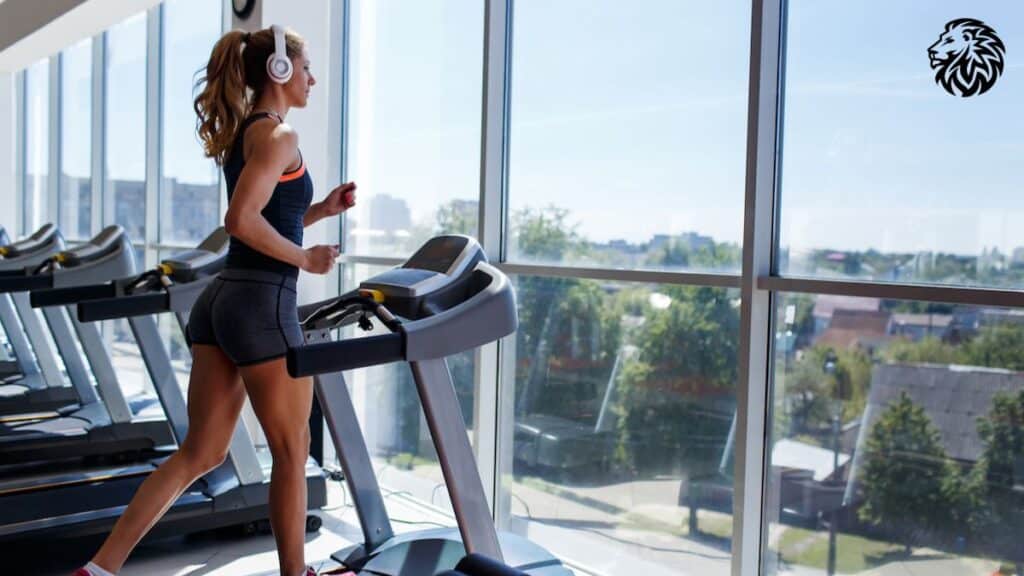Whether you’re a novice runner or a seasoned marathoner, treadmill workouts can offer a wealth of benefits. A treadmill isn’t just a refuge for runners when bad weather strikes. A treadmill can be a versatile piece of equipment that when used correctly. It can greatly contribute to your training regime, building speed, strength, and endurance. It also provides an element of control, allowing you to customize your workouts with precision in ways that running outdoors cannot always offer.
This article will introduce you to seven effective treadmill workouts specifically designed for runners. From speed intervals that boost your pace, hill simulations that build strength, to recovery runs that aid in muscular recuperation, there is something for everyone. Whether your goal is to run faster, longer, or simply to add variety to your running routine, these workouts can be tailored to your needs and goals. Let’s get started.
The Importance of Treadmill Workouts for Runners

While outdoor running undeniably offers an array of sensory experiences and engagement with varied terrains, treadmill workouts hold their own unique advantages, especially when it comes to structured training and consistency.
Differences between outdoor and treadmill running
Outdoor running often involves unpredictability, from changes in weather to varied surfaces and inclines. These factors can be beneficial for improving mental toughness and balance. In contrast, treadmill running provides a controlled environment which allows for precise control over speed, incline, and other factors. It can also reduce the impact on your joints due to the softer surface, potentially reducing injury risk.
Specific benefits of treadmill training for runners
- Controlled Environment: A treadmill allows for precision in training. You can set a specific pace, incline, and duration, which is especially helpful for interval training or speed workouts.
- Safety and Convenience: Running on a treadmill eliminates the need to worry about traffic, poor lighting, or adverse weather conditions. It also allows for multi-tasking, like watching a show or reading a book during your workout.
- Biofeedback: Treadmills provide instant feedback on speed, distance, time, and estimated calorie burn, which can help in tracking progress and keeping you motivated.
- Versatility: With the ability to simulate flat roads, steep hills, and everything in between, treadmill workouts can provide a wide range of training scenarios.
Incorporating treadmill workouts into your training routine can thus offer a balanced approach, supplementing outdoor runs with specific, controlled training that can help enhance performance and prevent injuries.
7 Effective Treadmill Workouts For Runners

Treadmill Workout #1: The Speed Intervals
Explanation of Speed Intervals
Speed intervals involve running at a high speed for a set duration or distance, followed by a recovery period at a slower pace. This pattern is then repeated for a certain number of cycles. For example, you may run fast for one minute, then recover for two minutes, repeating this cycle for a total of 20 to 30 minutes.
Benefits of this workout
Speed interval training improves both aerobic and anaerobic capacity. It enhances running speed and boosts cardiovascular fitness. By fluctuating between high-intensity bursts of speed and recovery periods, your body learns to recover more quickly after bursts of strenuous activity, which can help improve overall running performance.
Step-by-step instructions on how to perform it
- Begin with a 5-10 minute warm-up at a comfortable jogging pace.
- Increase the treadmill speed to a challenging but sustainable pace for one minute.
- After this minute, slow the treadmill to a comfortable pace for a two-minute recovery period.
- Repeat this high-intensity and recovery cycle for 20 to 30 minutes.
- Finish with a 5-minute cooldown at a comfortable jogging or walking pace.
Remember, the high-intensity speed should be challenging but sustainable for the full minute. Over time, you can increase the speed or duration of the fast intervals, or decrease the length of the recovery periods, to continually challenge yourself and make progress.
Treadmill Workout #2: The Hill Simulation
Explanation of Hill Simulation
Hill simulation workouts on a treadmill involve adjusting the incline to mimic the challenge of running uphill. The treadmill’s ability to control incline levels precisely makes it a perfect tool for this type of workout.
Benefits of this workout
Running uphill challenges your cardiovascular system and strengthens key running muscles like your glutes, hamstrings, calves, and quads. It also improves your running form, as uphill running naturally encourages high knee drive and quick foot turnover. Over time, hill workouts can help improve speed, power, and endurance, making flat runs feel easier.
Step-by-step instructions on how to perform it
- Begin with a 5-10 minute warm-up at a flat incline and a comfortable pace.
- Increase the incline to simulate a moderate hill (e.g., 4-6% incline) and maintain this for one minute.
- Return to a flat incline for a two-minute recovery period.
- Repeat this cycle for 20-30 minutes.
- Finish with a 5-minute cooldown at a flat incline and a comfortable pace.
The incline should be challenging but sustainable for the duration of the ‘hill’. As your fitness improves, you can increase the incline or the duration of the hill intervals, or decrease the recovery time, to keep challenging yourself. Remember to maintain good form throughout, leaning slightly into the hill but keeping your back straight, driving your knees high, and swinging your arms.
Treadmill Workout #3: The Progressive Run
Explanation of Progressive Run
A progressive run is a workout where you gradually increase your speed throughout the run. It usually begins at a comfortable pace, and then every few minutes or set distance, you increase the speed until you are running at a challenging pace by the end.
Benefits of this workout
Progressive runs help improve running efficiency, increase lactate threshold (the point at which fatigue starts to set in), and boost endurance. They also teach you how to pace yourself and finish strong, both of which are crucial skills for race running.
Step-by-step instructions on how to perform it
- Begin with a 5-10 minute warm-up at a comfortable pace.
- After the warm-up, set a pace that you can comfortably maintain.
- Every 5 minutes, increase the speed slightly (0.1 – 0.2 mph).
- Continue this pattern of increasing speed every 5 minutes for the duration of your run, which could be anywhere from 20 to 45 minutes based on your fitness level and available time.
- Finish with a 5-minute cooldown at a comfortable pace.
The goal here is not to sprint at the end but to finish at a pace faster than where you started. The incremental increases should be challenging but sustainable. As your fitness improves, you can increase the amount by which you increase the speed, or the overall duration of the run, to continue challenging yourself.
Treadmill Workout #4: The Tempo Run
Explanation of Tempo Run
A tempo run, also known as a threshold run, is a workout where you run at a “comfortably hard” pace for a sustained period. This is usually at a pace where you can only speak in short, broken sentences. The aim is to run at just below your anaerobic threshold, the point at which lactic acid begins to accumulate in your muscles faster than it can be cleared.
Benefits of this workout
Tempo runs improve metabolic fitness by increasing your lactate threshold. This means you can run faster, for longer, before fatigue sets in. They also help improve mental toughness as maintaining a challenging pace for an extended period can be as much a mental challenge as a physical one.
Step-by-step instructions on how to perform it
- Begin with a 10-minute warm-up at a comfortable pace.
- Increase the speed to your estimated tempo pace. This should feel challenging but sustainable. You should be able to maintain this pace for at least 20 minutes.
- Hold this tempo pace for 15-20 minutes. Over time, as you get fitter, you can increase this duration.
- Finish with a 10-minute cooldown at a comfortable pace.
Remember that your tempo pace is unique to you and may take some trial and error to find. Start conservatively and adjust as needed. As you become more experienced, you will get a better sense of what tempo pace feels like. A heart rate monitor or running watch can also help you keep track of your effort level.
Treadmill Workout #5: The Fartlek Workout
Explanation of Fartlek Workout
Fartlek is a Swedish word meaning “speed play”. It’s a form of interval training that alternates between faster and slower running, but unlike traditional interval training, it is unstructured and varies in intensity and duration. This means you control the intensity and duration of each “fast” and “slow” interval based on how you feel.
Benefits of this workout
Fartlek workouts improve both aerobic and anaerobic fitness, help you become more comfortable with varying paces, and break up the monotony of steady-paced running. They can also be a fun way to increase your running speed and stamina without the pressure of hitting specific time goals.
Step-by-step instructions on how to perform it
- Start with a 5-10 minute warm-up at a comfortable jogging pace.
- After your warm-up, increase the speed to a challenging but sustainable pace for a random amount of time (e.g., one to five minutes).
- Then, decrease the speed and recover at a comfortable pace for another random duration.
- Repeat this pattern of random high and low-intensity intervals for 20-30 minutes.
- Finish with a 5-minute cooldown at a comfortable pace.
The beauty of a Fartlek workout is its flexibility. The lengths of the fast and slow intervals are entirely up to you, as is the speed. You can tailor the workout to your fitness level and how you feel on the day. Just remember to challenge yourself during the fast intervals and allow yourself to fully recover during the slow ones.
Treadmill Workout #6: The Recovery Run
Explanation of Recovery Run
A recovery run is a relatively short, easy run performed at a comfortable pace. It’s often done after a hard workout or race. The goal isn’t to push your pace or distance but to move gently and help your body recover.
Benefits of this workout
Recovery runs help to promote blood flow to the muscles, which aids in flushing out lactic acid and other metabolic waste products. They help to reduce muscle soreness and stiffness, promote recovery, and prepare your body for your next hard workout. They also offer a chance to enjoy running without the pressure of hitting a certain pace or distance, which can be beneficial for mental recovery.
Step-by-step instructions on how to perform it
- Begin with a few minutes of walking or slow jogging as a warm-up.
- Set the treadmill to a comfortable jogging pace. You should be able to hold a full conversation easily at this pace.
- Continue at this comfortable pace for 20-30 minutes, or however long feels good. The focus here is on time spent moving, not distance covered.
- Finish with a few minutes of walking as a cool down.
Remember, the goal of a recovery run is to feel better at the end than you did at the start. If you’re still feeling fatigued after a recovery run, you might be going too fast or running for too long. It’s better to err on the side of too easy for recovery runs. As a guide, aim to run at least 1-2 minutes per mile slower than your usual training pace.
Treadmill Workout #7: The Long, Slow Distance Run (LSD)
Explanation of Long, Slow Distance Run
Long, Slow Distance (LSD) runs are just as they sound — they involve running a longer distance than usual at a slow, comfortable pace. These runs make up the cornerstone of many training programs, especially for long-distance races like half-marathons and marathons.
Benefits of this workout
LSD runs help to build endurance and mental toughness, crucial for long-distance running. They enhance your body’s ability to burn fat as fuel and improve your cardiovascular system’s efficiency. These runs also allow you to practice fueling and hydration strategies for longer events.
Step-by-step instructions on how to perform it
- Begin with a few minutes of walking or slow jogging to warm up.
- Set the treadmill to a slow, comfortable pace — you should be able to hold a conversation easily at this pace.
- Continue at this pace for a long duration (usually over an hour, but this can vary based on your current fitness level and the distance of the races you are training for). Remember, the focus is on duration rather than speed.
- Finish with a few minutes of walking as a cool down.
When doing LSD runs on a treadmill, it’s important to remember to stay hydrated, as you would during a long run outdoors. You can also set the treadmill to a 1% incline to better simulate outdoor running. Over time, gradually increase the duration of your LSD runs as your endurance improves. As always, listen to your body and adjust the pace and duration as needed.
Conclusion

This article has presented seven effective treadmill workouts for runners of all levels. Each workout has unique benefits and can be adapted to meet individual fitness goals. We’ve discussed Speed Intervals, Hill Simulation, Progressive Runs, Tempo Runs, Fartlek Workouts, Recovery Runs, and Long, Slow Distance Runs. Additionally, we provided essential tips for getting the most out of treadmill running, including setup, safety, posture, and how to incorporate these workouts into an overall running plan.
Treadmill running can be a powerful tool in any runner’s arsenal. From beginners to seasoned marathoners, these workouts offer a controlled environment to improve speed, build endurance, and enhance running efficiency. It’s encouraged for runners to try these workouts, adapt them to their needs, and experience the benefits that treadmill running can offer.
While running outdoors has its unique perks, never underestimate the versatility and effectiveness of a good treadmill workout. Regardless of the weather or time of day, the treadmill is always ready. It’s an excellent tool for precise, targeted training and can be a great way to keep your running routine fresh, challenging, and enjoyable. Whether you’re training for a race or just looking to stay fit, these treadmill workouts can help you reach your running goals.







